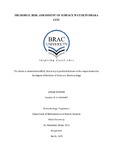Microbial risk assessment of surface waters in Dhaka
Abstract
The purpose of the research work is to examine the water quality of three major water sources of Dhaka city on basis of the presence of microbial contamination. This research has been carried out for a year and the presence of total coliform and the fecal coliform in the surface waters of Dhaka city have been measured. During the study, water samples were collected from three water bodies (Hatirjheel Lake, Gulshan Lake, and Buriganga River) during two seasons (winter and summer). Average coliform counts for single grab samples from Hatirjheel, Gulshan, and Buriganga were 3475 cfu/ml, 7112cfu/mL, 10610cfu/mL respectively during summer and 15860 cfu/ml, 9990 cfu/mL, 45400 cfu/mL respectively during winter. Similarly, average fecal coliform counts for single grab samples from Hatirjheel, Gulshan, and Buriganga were 390cfu/mL, 1352cfu/mL, 362cfu/mL respectively during summer and 447cfu/mL, 183cfu/mL, 923cfu/mL respectively during winter. While total coliform counts were higher during summer, fecal coliform contamination was generally higher during winter in these water bodies. Overall, all three water bodies were heavily polluted with counts of fecal indicator bacteria being two orders of magnitude higher than the maximum permissible limit for water bodies to be used for recreation purpose. Therefore, this study highlights the importance for implementing mitigation strategies to make these water bodies safe for human activities.

